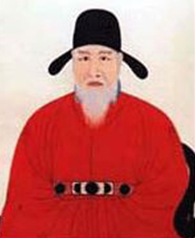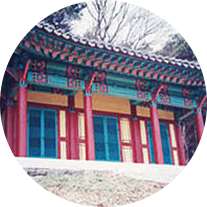Choi Yeong

- Pen name Mumin
- Period Late in Goryeo Dynasty (1316 ~ 1388)
- Field Politics
Born to the family clan, Dongju, in Hongju Jeokdong (currently Noeun-ri, Hongbuk-myeon, Hongseong-gun) as a son of Won-jik, an inspection officer service, and as a descendant (5th generation) of Yu-cheong, who had held a Pyeongjangsa post.
He suppressed the revolt of Jo Il-sin in 1352 (1st year of King Gongmin's reign). In 1358, he defeated the Japanese army, which invaded the Oye port with a fleet of 400 ships, through a surprise attack. When 40,000 Red Turbans invaded Goryeo in 1359 and overtook Seogyeong, he defeated them togther with several other commanders. When 100,000 Red Turbans invaded again in 1361, leading to the collapse of Gaegyeong, he went to war with An Woo and Yi Bang-sil to defeat the enemy and reclaim Gaegyeong. When the Japanese army invaded Yeonsan Gaetaesa in 1367 (2nd year of King Woo’s reign), he volunteered to serve in battle despite his old age and led his army into victory. For the meritorious deed, he was appointed as the vice-governor of Cheorwon. When the Japanese army invaded Seungcheonbu in 1378, he defeated the army with Yi Seong-gye and Yang Baek-yeon, and became a Munjasijung and then Panmunhabusa in 1384.
In 1388, when the Ming Dynasty proclaimed to build a military facility called Cheollyeongwi to bring the north, west and east of Cheollyeong under Yodong, he became determined to defeat the Ming army and went to Pyeongyang together with King to encourage the troops as Paldodotongsa (General of 8 provinces). At the same time, he ordered Jo Min-su, the left army general, and Yi Seong-gye, the right army general to attack Yodong with 38,800 soldiers. However, Yi convinced Jo to retreat from Wihwa-do, and the attack ended in failure. Choi Yeong was captured by Yi and sent exile to Gobonghyeon (present-day Goyang) before being relocated to Happo (present-day Masan) and Chungju. Later, he was sent back to Gaegyeong, where he was placed in a military prison and he was beheaded in December in that same year.
After hearing the news of his death, the people of Gaegyeong expressed their grief behind closed doors. It has been said that everyone throughout the country lamented his death. 6 years after Yi founded a new dynasty, Yi gave him a posthumous epithet called Mumin to comfort his soul. Because the area around his tomb, which is located in Daeja-dong, Deogyang-gu, Goyang-si, Gyeonggi-do, remains grassless, it is called Jeokbun (red tomb).
Main Historical Site
- Name Gibongsa (a shrine for General Choi Young)
- Location Noeunli Hongseonggun Hongbukmyeon Chungcheongnamdo
It is recorded in [Shinjeung Dongguk Yeojiseungram] Hongjumok Sancheon edition that the shrine of General Choi Young is located at about 9.2km east of Bonju, “Sambong Mountain. Among the summits of a mountain, the shrine is around at the middle peak. It was torn down in 1970’s but reconstructed in 1995. A memorial service is held in every fall.
In 1995, Hongseonggun held the first memorial service for General Choi Young in a cultural event. After 1996, it held a memorial service to comfort General Choi Young’s soul.
